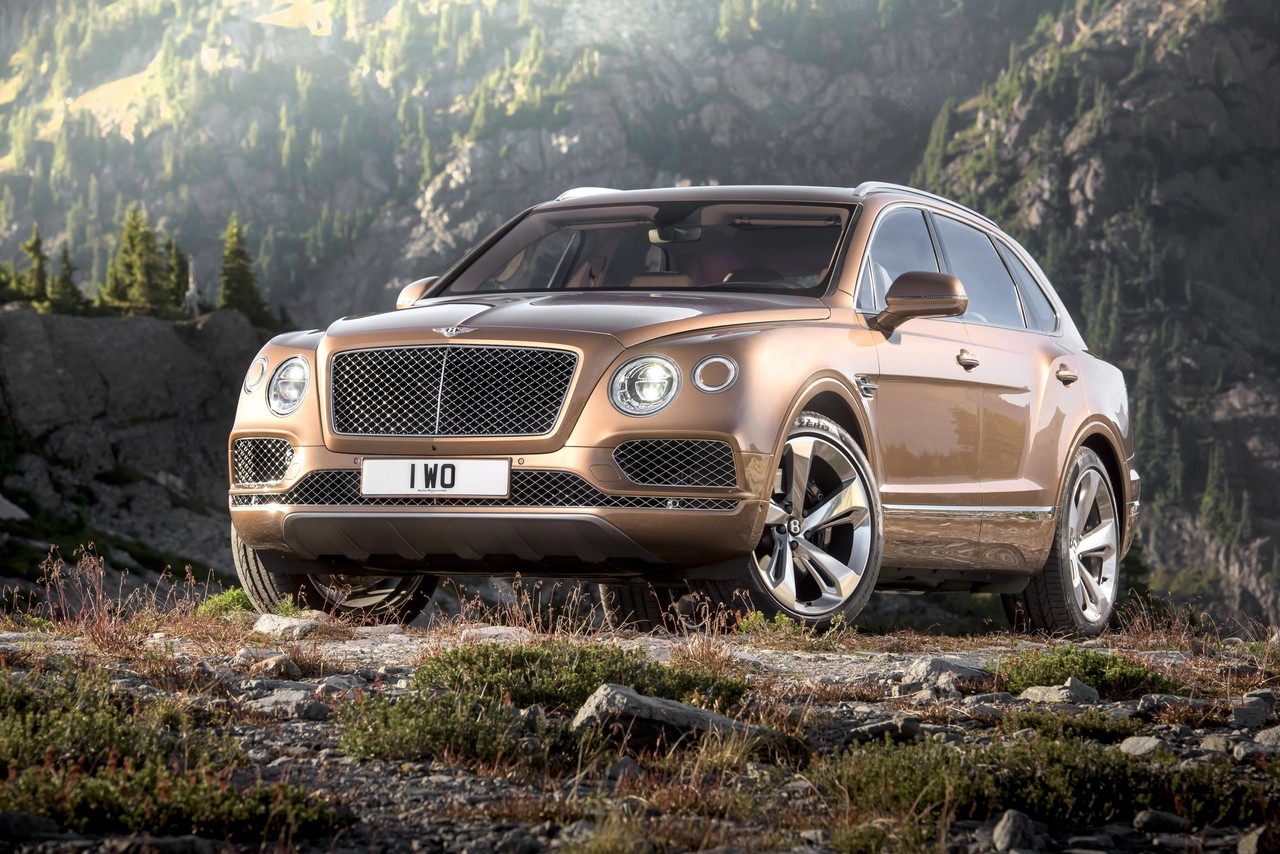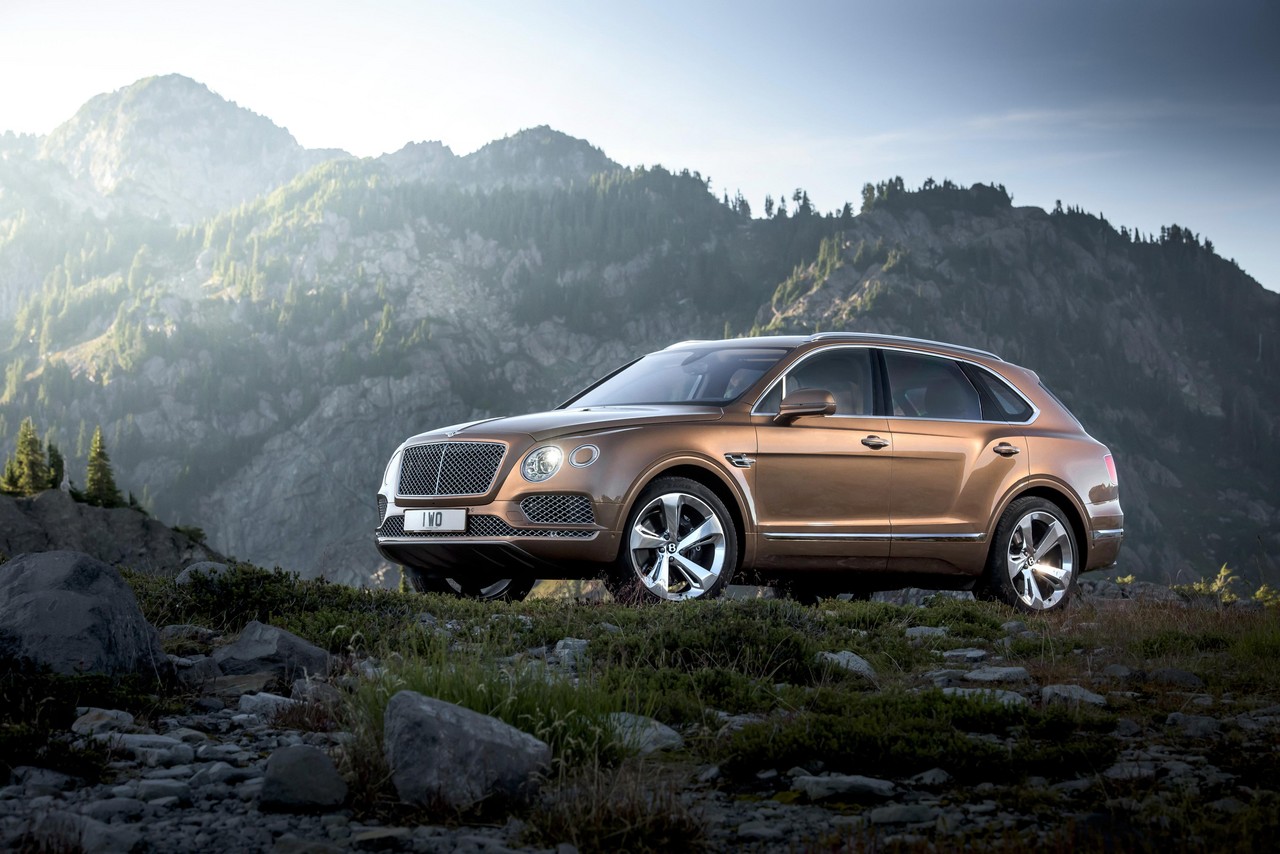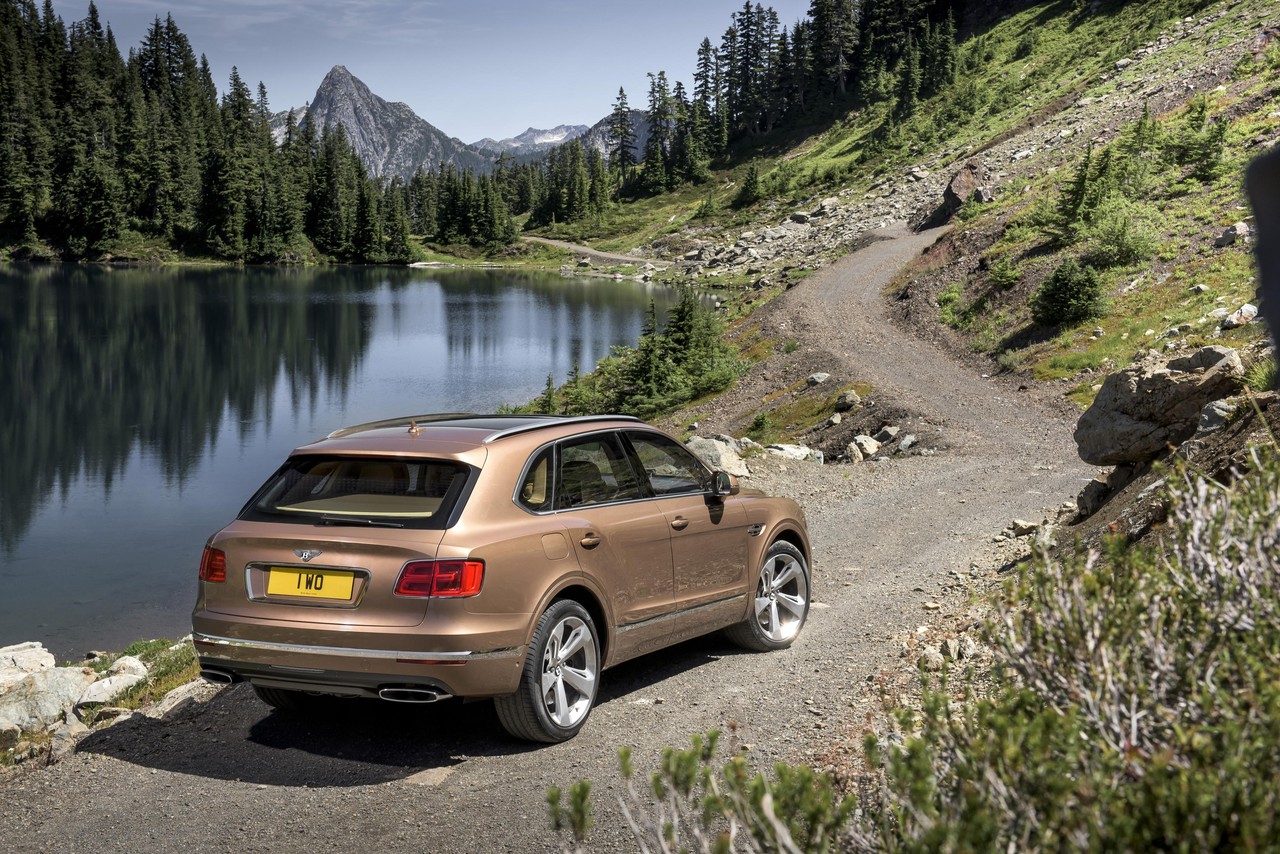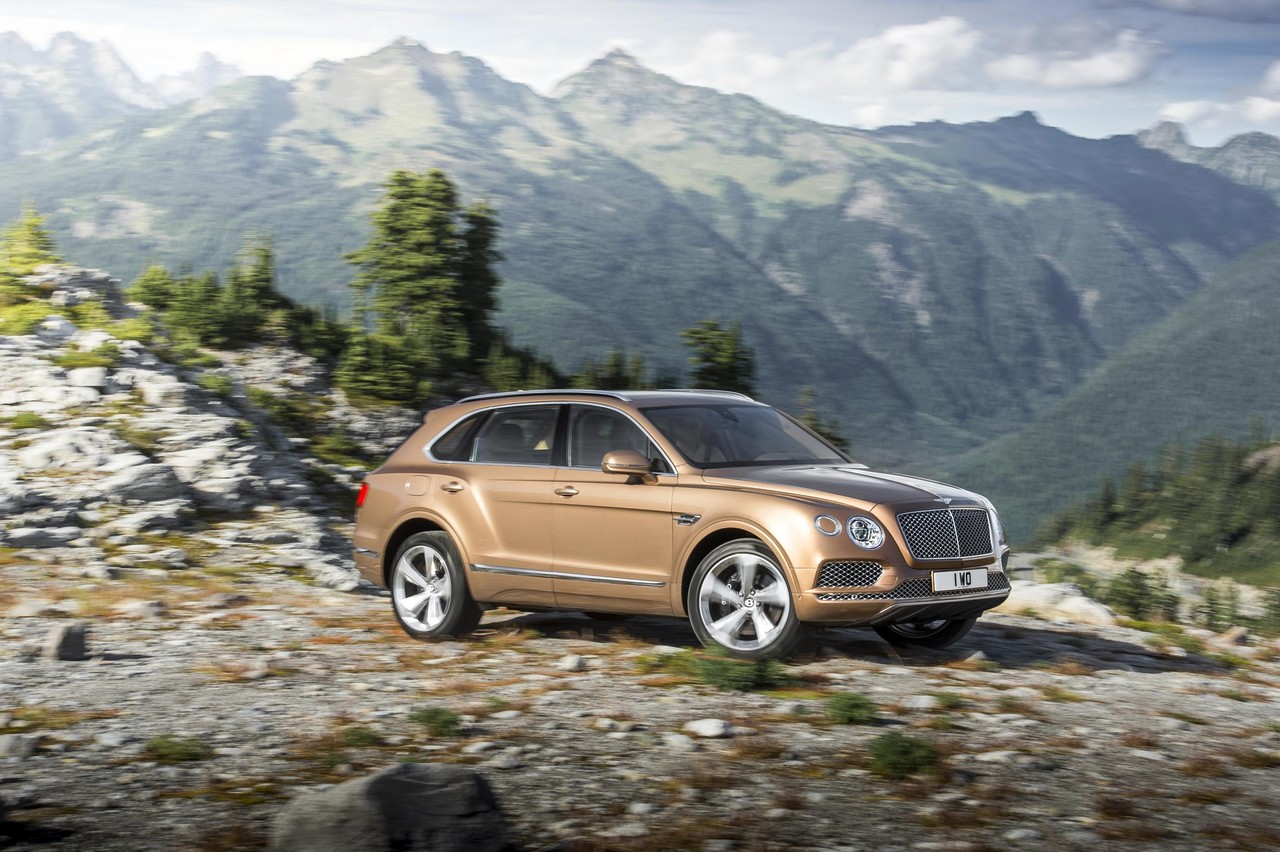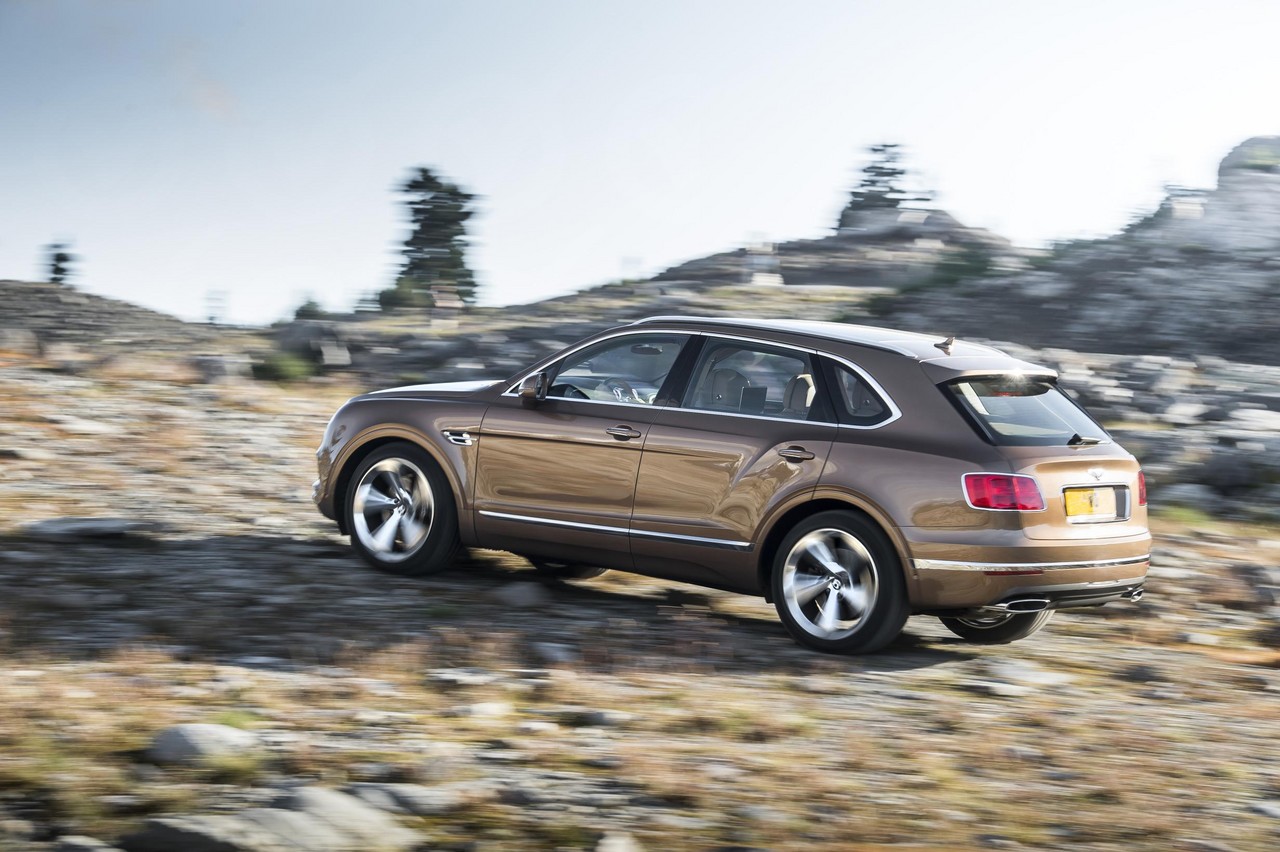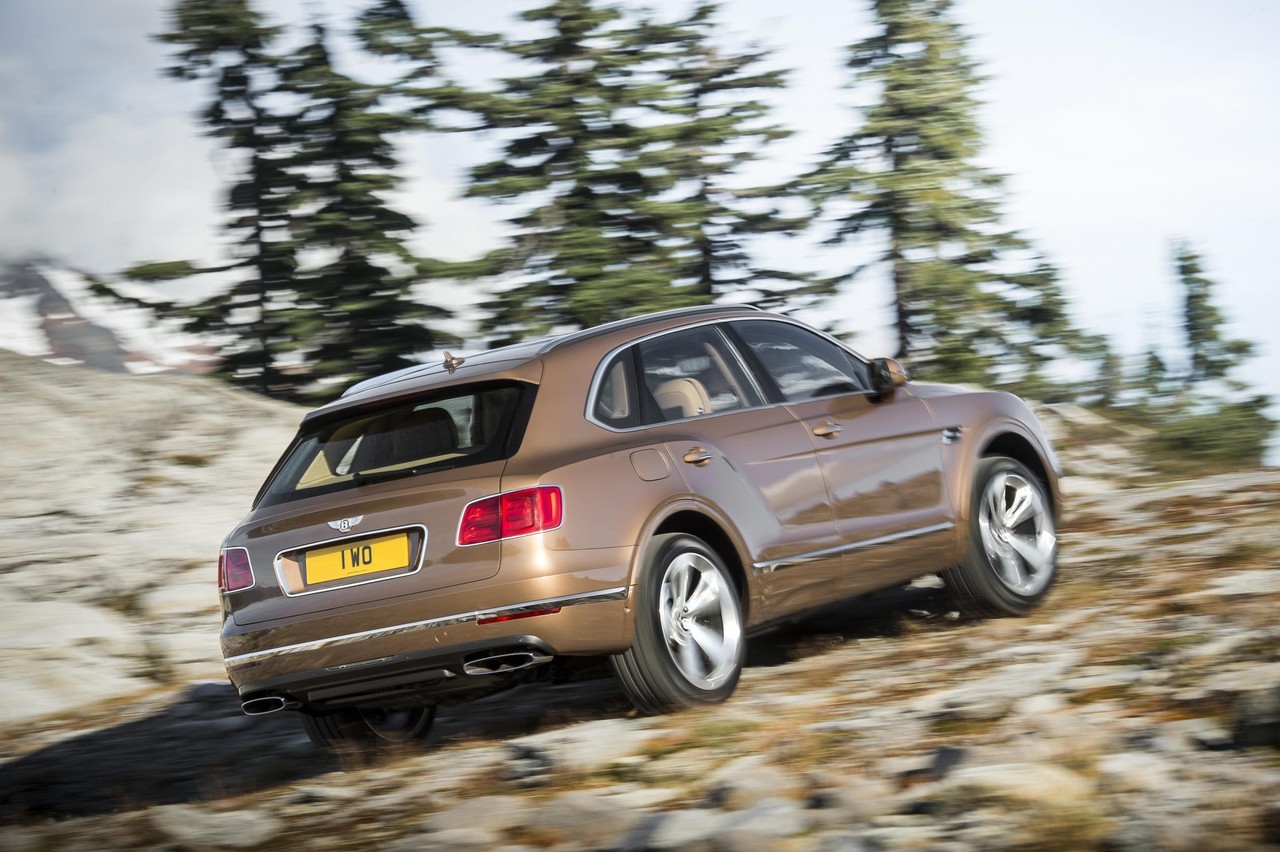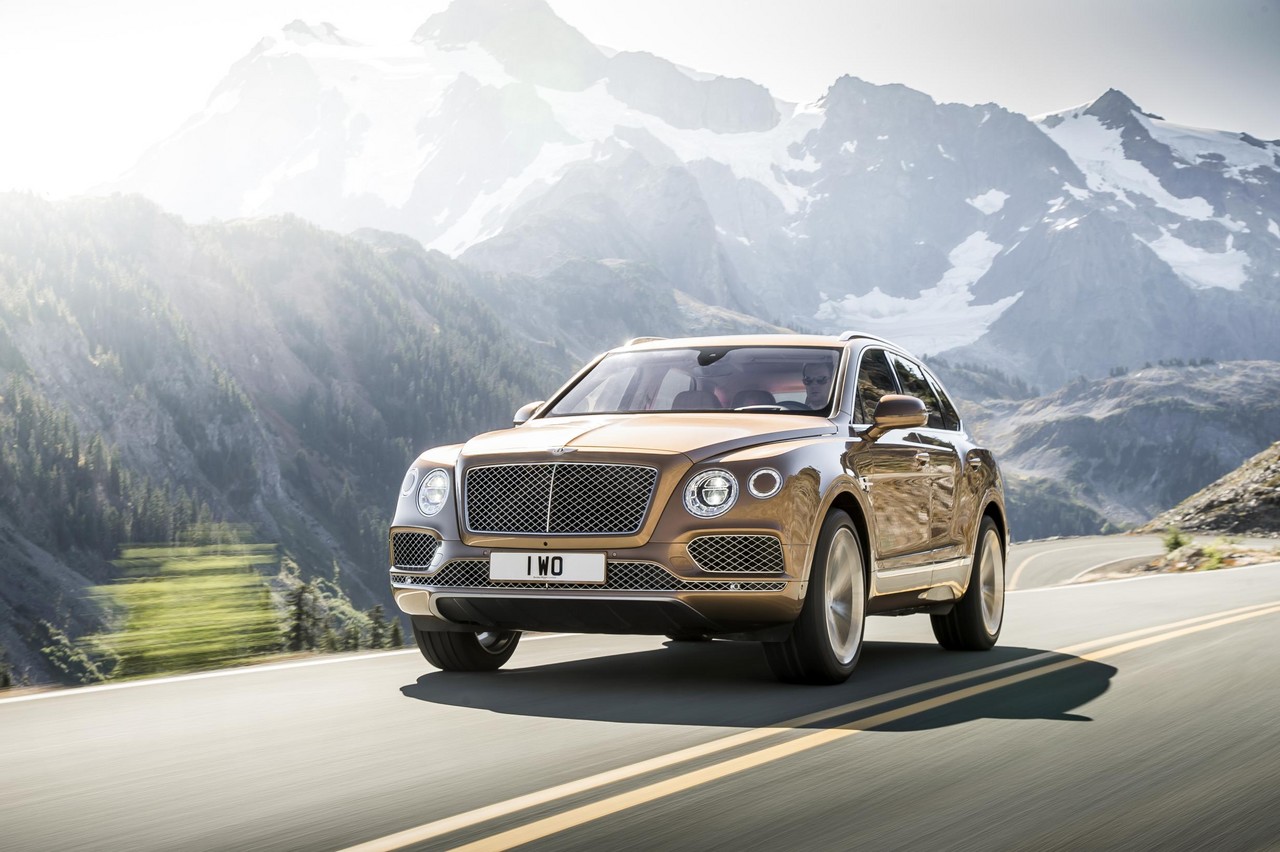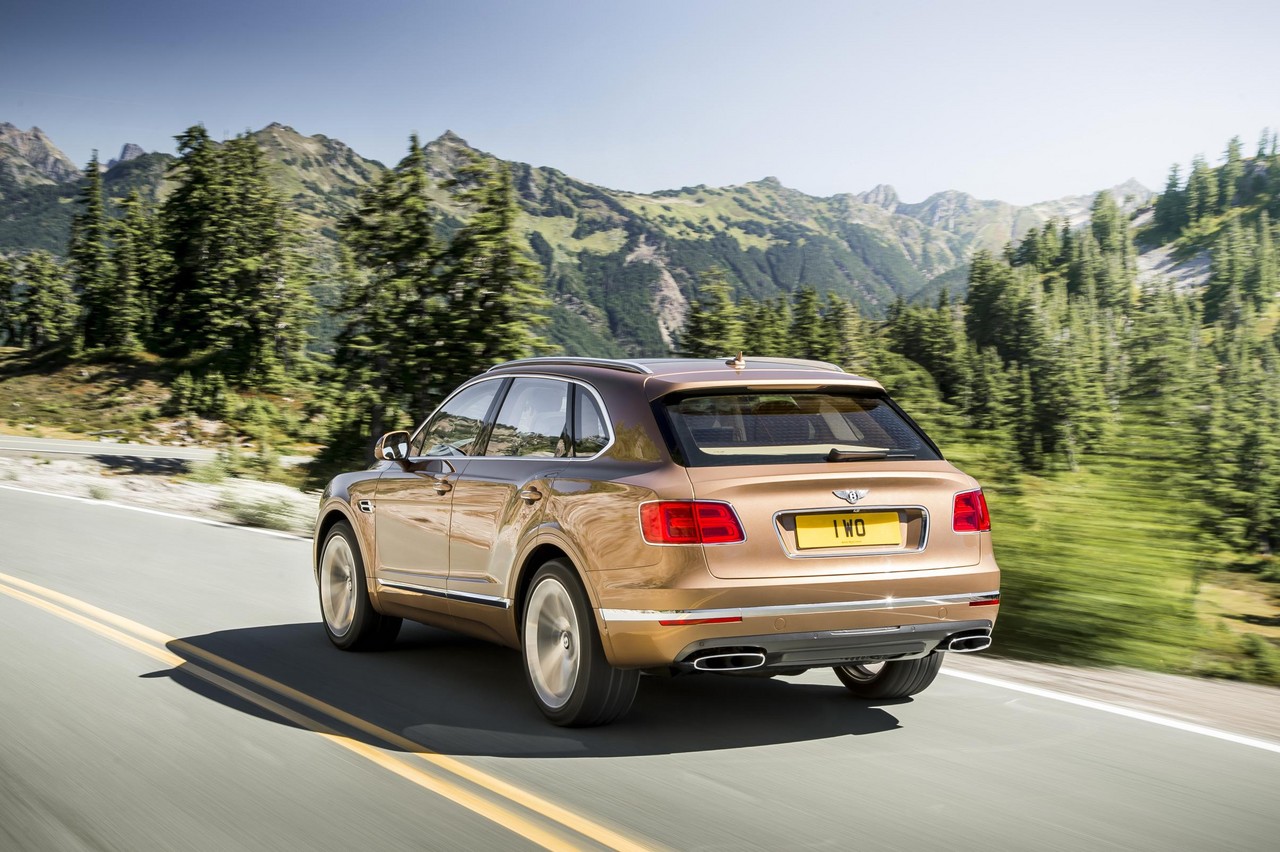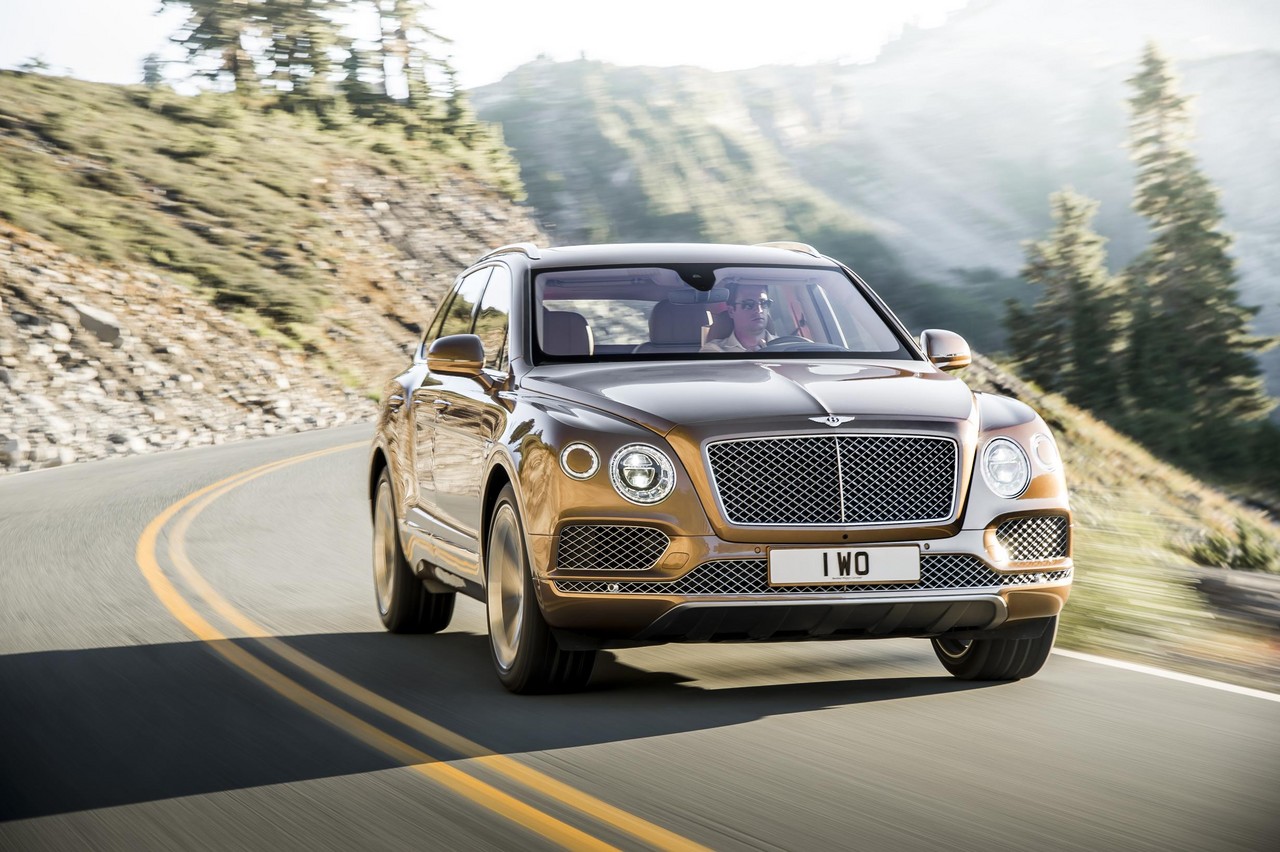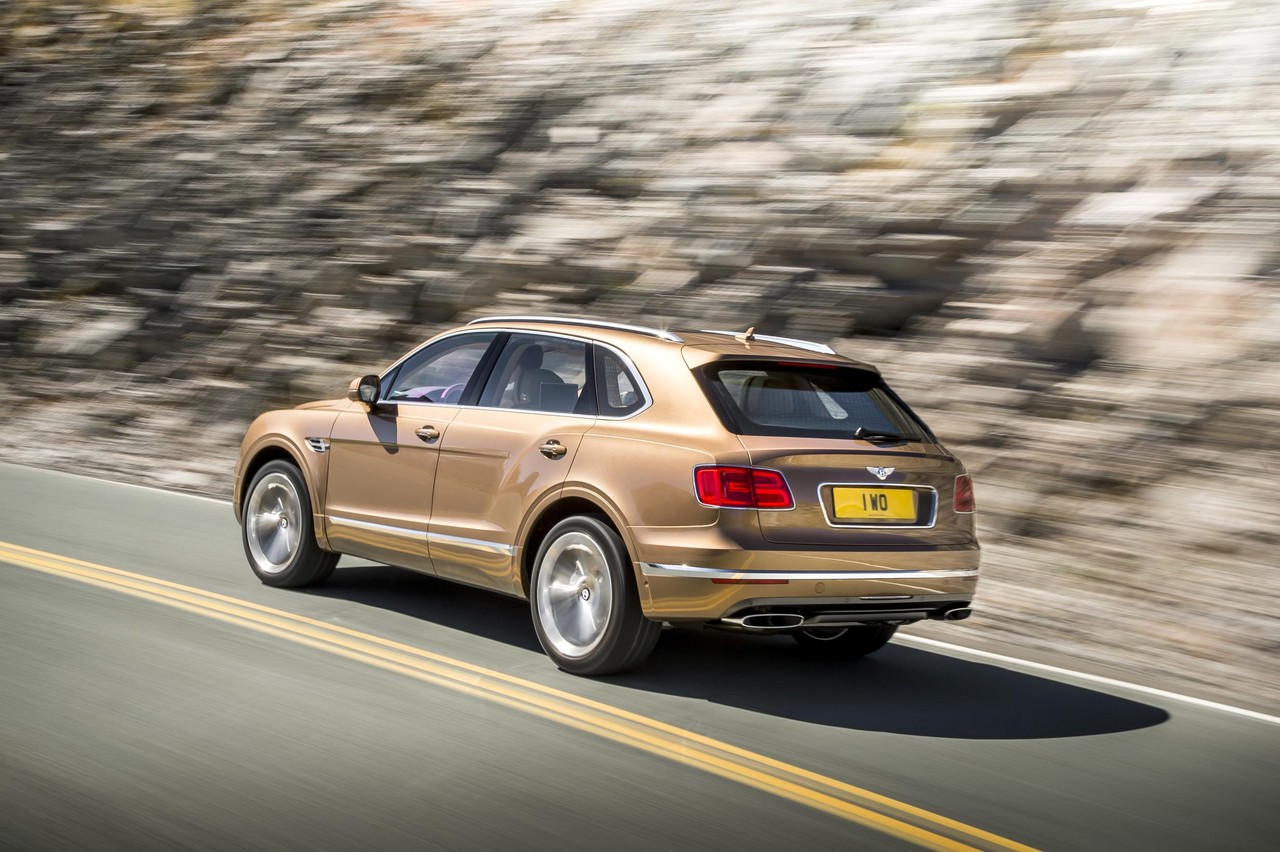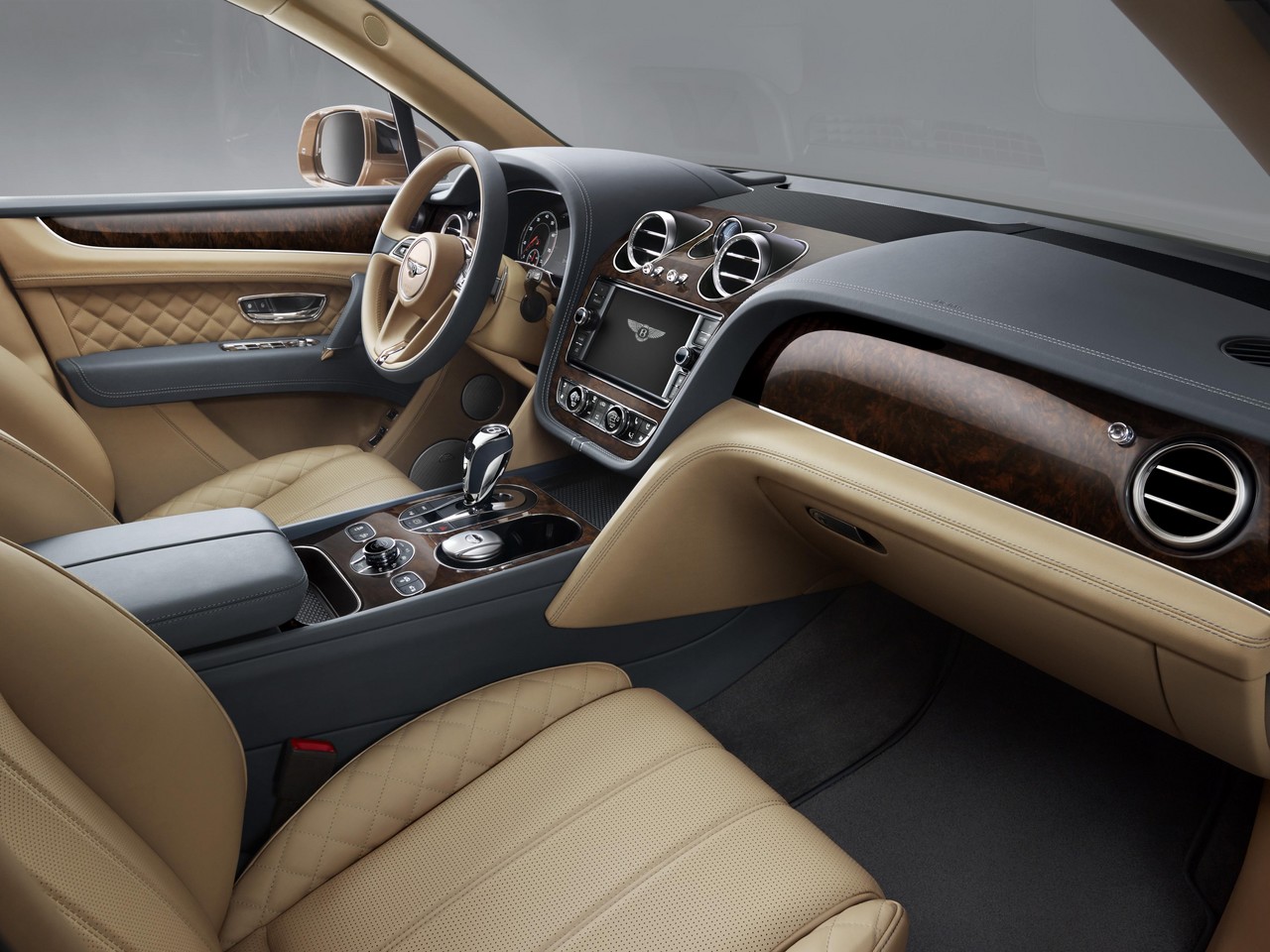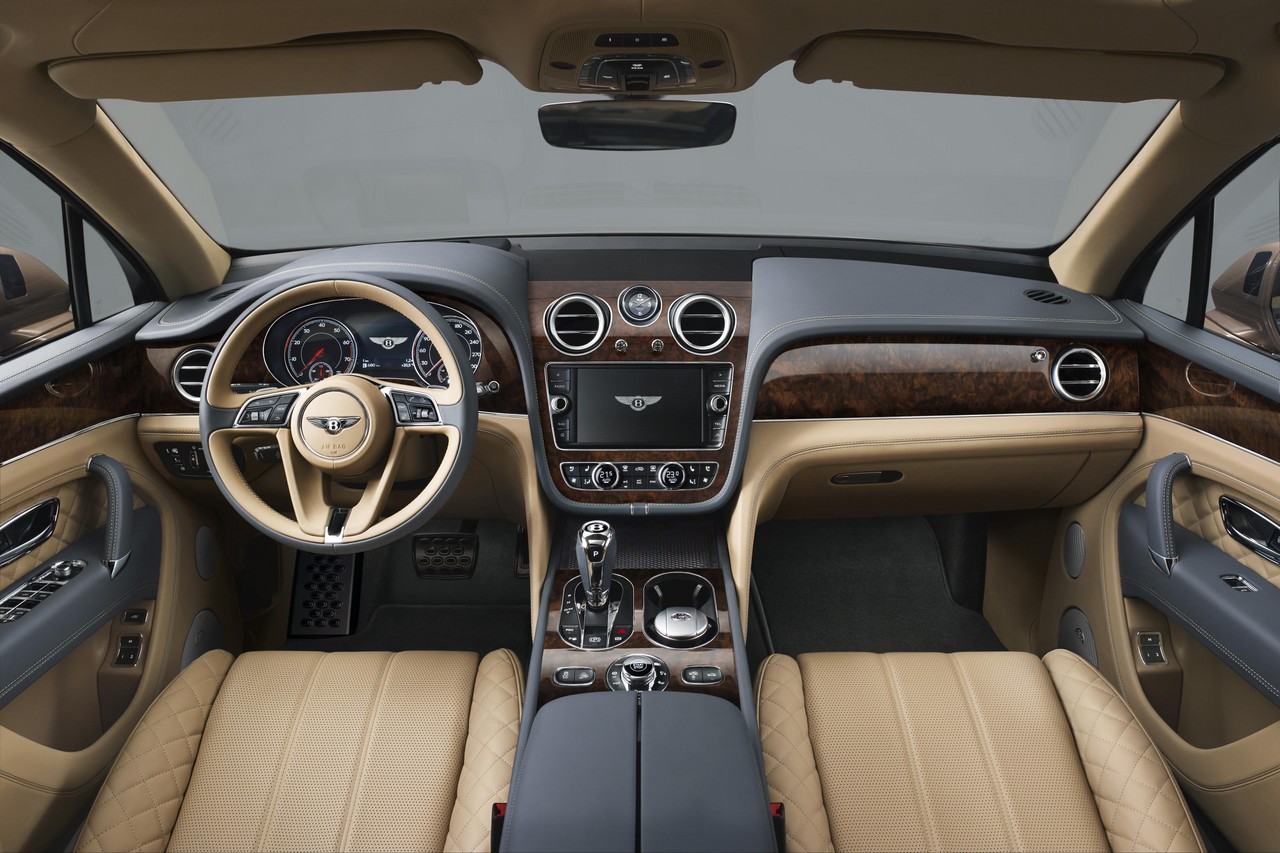
- Powerful 5950 cc W12 engine
- Opulent interior
- Air suspension provides comfortable ride
- Quiet, well-insulated cabin
- Off-road capability
- Autonomous braking (‘Bentley Safeguard’) not standard. Seriously.
- Steering lacks feel
- Massive price premium to related Audi 4M Q7
- Nobody takes a car this expensive off-road. So why are you buying it?
- Fuel consumption
Overview
Released in Australia in March 2016, the Bentley 4V Bentayga was a large, four-wheel drive SUV. The Bentley Bentayga was initially powered by a 6.0-litre twin-turbo W12 engine that was mated to an eight-speed ZF AL952 automatic transmission. While the Bentley Bentayga was manufactured in Crewe, UK, its bodyshell was produced in Bratislava, Slovakia.
From April 2017, the Bentley Bentayga was available with a 4.0-litre diesel engine.
Bentley Bentayga: W12 biturbo engine
The 5950 cc W12 petrol engine (engine code: DDBB) had an aluminium-alloy cylinder block, a die-forged steel crankshaft, a cast aluminium alloy cylinder head, double overhead camshafts (chain driven by three simplex roller chains), four valves per cylinder, variable intake and exhaust camshaft timing, direct and indirect (i.e. conventional port) fuel injection) and a turbocharger for each cylinder bank.
To reduce fuel consumption, the Bentayga’s W12 petrol engine had:
- Bentley’s ‘Variable Displacement’ system which could shut down half of the engine – i.e. the valves, fuel injection and ignition – when running gears 3 to 8, engine speed is below 3000 rpm and less than 300 Nm was required;
- A Stop-Start function which enabled the engine to shut down when the vehicle was at neat stationary speeds (and not just when the vehicle was stationary); and,
- A coasting function which operated in gears 5 to 8 to open the torque converter, reduce engine speed to idle and enable the car to coast without the effect of engine braking.
The Bentley Bentayga W12 could accelerate from rest to 100 km/h in 4.1 seconds and had a top speed of 301 km/h. Over the combined EU test cycle, fuel consumption was 12.8 litres per 100 km.
Bentley Bentayga: V8 triple turbo diesel engine
Although described as a triple turbo engine, the 3956 cc diesel engine has:
- Two variable geometry, sequential twin-scroll turbochargers which are driven by exhaust gases; and,
- An supercharger that was powered by the vehicle’s 48 volt electrical system and could spool up within 30 microseconds to eliminate turbo lag.
The Bentayga’s V8 diesel engine also has a stop-start system and Selective Catalytic Reduction (SCR) which injects a urea solution into the exhaust gases to convert nitrous oxides into nitrogen gas and water.
The Bentley Bentayga V8 Diesel could accelerate from rest to 100 km/h in 4.6 seconds and have a top speed of 270 km/h. Over the combined EU test cycle, fuel consumption was 7.9 litres per 100 km.
| Engine | Years | Trans. | Peak power | Peak torque |
|---|---|---|---|---|
| 5950 cc DDBB twin turbo petrol W12 | 2016-on | 8sp auto | 447 kW at 5250-6000 rpm | 900 Nm at 1250-4500 rpm |
| 3956 cc triple turbo diesel V8 | 2017-on | 8sp auto | 320 kW at 3750-5000 rpm | 900 Nm at 1000-3250 rpm |
4WD system
The Bentley Bentayga’s 4WD system utilised Torsen centre differential and an open rear differential. In normal conditions, the system provided a 40:60 front:rear torque split. As standard, the Bentayga had a Hill Descent Control (HDC) function which could control vehicle speed – within a range of 2 km/h and 30 km/h – on declines with gradients exceeding five per cent.
The Bentley Bentayga could be specified with an optional, extra-cost ‘Responsive Off-Road Setting’ which enabled the driver to select appropriate vehicle settings for the following situations –
- Snow & Grass: for slippery surfaces;
- Dirt & Gravel: for loose surfaces;
- Mud & Trail: for steep gradients and obstacles; and,
- Sand Dunes: for surf driving in deep sand.
When activated, the Driver Information Panel would display information on pitch, roll, wheel articulation, steering angle, compass bearing and altitude.
Body and dimensions
The Bentley 4V Bentayga was underpinned by Volkswagen’s MLB platform which was shared with the Audi 4M Q7 and Audi 4M SQ7 . As such, the Bentley Bentayga was 5140 mm long, 1998 mm wide (excluding mirrors), 1722 mm tall and had a 2995 mm long wheelbase. Furthermore, the Bentayga W12 had an unladen weight of 2383 kg.
The Bentley Bentayga was initially offered in four and five seat configurations, with a seven seat option to follow. Where fitted, the two individual rear seats had eighteen-way power adjustment, massage and ventilation functions, and footrests.
Suspension
The Bentley 4V Bentayga had four-link, double wishbone front suspension and trapezoidal multi-link rear suspension. The suspension included air springs for a multi-mode system that enabled the driver to select from different ride heights (High 2, High 1, Normal and Low). The suspension also had a self-levelling function and ‘Continuous Damping Control’ as standard. Using a rotary controller, the driver could select from four driving modes –
- Sport: for maximum body control;
- Comfort: for optimised comfort and refinement;
- Bentley: a blend of Sport and Comfort settings devised by Bentley’s chassis engineers; and,
- Custom: allowed the driver to select individual settings for the various systems.
The main suspension had maximum travel of 225 mm, while ground clearance in the highest setting was 245 mm. Furthermore, the Bentayga had a maximum wading depth of 600 mm.
As an extra-cost option, the Bentley Bentayga could be specified with electric-powered (48V) active anti-roll bars (‘Bentley Dynamic Ride’). According to Bentley, Bentley Dynamic Ride counter-acted lateral rolling forces when cornering to ensure maximum tyre contact.
Steering
The Bentley Bentayga had rack-and-pinion steering with electric power assistance and a variable ratio. The steering wheel required 2.3 turns from lock-to-lock, while the Bentayga had a turning circle of 12.4 metres.
Safety equipment
Standard safety equipment for the Bentley Bentayga included dual front airbags, front seat-mounted side airbags, full-length curtain airbags (i.e. for front and second row occupants), ABS, electronic brake force distribution, brake assist, electronic stability control, traction control and front seatbelts with pre-tensioners and load limiters.
The Bentley Bentayga was equipped ‘Driver Assistance Systems’ (DAS) which used ultrasonic sensors, cameras and radars to interpret traffic conditions. As standard, the Bentayga was equipped with:
- High Beam Assist: automatically dipped the high beam headlights if oncoming vehicles were detected and adapted the shape of the light beam according to vehicle speed;
- Blind Spot Warning: active at speeds from 10 km/h to 250 km/h, the driver received visual warnings – via flashing lights in the door mirrors – if vehicles were detected in the driver’s blind spot; and,
- Exit Warning: warned vehicle occupants of objects approaching from the rear of the car where there was a risk of collision if a door was opened.
The Bentayga’s optional, extra-cost ‘City Specification’ included five additional assistance systems:
- Traffic Sign Recognition: detected traffic signs and displayed their information to the driver. Furthermore, speed limits were shown in the Head Up Display;
- Pedestrian Warning: detected pedestrians and, if a collision was likely, issued a warning to the driver and pre-conditioned the braking system for deployment;
- Rear Crossing Traffic Warning: used a radar to detect approaching traffic which may cross the vehicle’s path as it reversed from a parking space;
- Top View: displayed a virtual top-down image on the central MMI screen of the vehicle’s surroundings based on images provided by four cameras; and,
- Park Assist: detected suitable parallel and perpendicular parking spaces and provided autonomous steering to manoeuvre the Bentayga into those spaces.
For the Bentley Bentayga First Edition, the ‘City Specification’ was fitted as standard.
Beyond this, the Bentley Bentayga’s optional ‘Touring Specification’ included the following systems for highway and long-distance driving:
- Adaptive Cruise Control, including stop & go, Predictive ACC and Traffic Assist: could maintain a set distance to the vehicle ahead – at speeds up to 250 km/h – by providing autonomous acceleration and braking. The Predictive ACC function used navigation data, sensors and cameras to predict upcoming corners, town entrances and speed limit changes, and then modified vehicle speed accordingly. In traffic, the system could detect columns of vehicles and initiate small steering inputs to keep the car in line without visibility of road markings;
- Bentley Safeguard: scanned the road ahead and, if a potential frontal collision was detected, warned the driver. If the driver did not respond, Bentley Safeguard could automatically apply the brakes such that collisions from speeds below 50 km/h could be prevented and, at higher speeds, their severity reduced;
- Active Lane Assist: operating at speeds above 60 km/h, Active Lane Assist used a video camera to scan the road ahead and applied small steering inputs to keep the car in its lane;
- Night Vision: used an infra-red camera and displayed an image of the road ahead on the central Driver Information Panel, extending visibility beyond the range of the headlights. Where a pedestrian, cyclist or large animal was detected, they were highlighted and the driver received a warning if they were in the path of the vehicle; and,
- Head Up Display: warnings and vehicle information – including speed and navigation instructions – were projected into the driver’s field of view in a virtual image through the windscreen.
Brakes
The Bentley Bentayga had 400 mm by 38 mm ventilated iron front brake discs and 380 mm by 30 mm ventilated iron rear discs.
Features: Bentley Bentayga
Standard features for the Bentley Bentayga included 10.0J x 21-inch alloy wheels with 285/45 R21 tyres, a ten speaker sound system, HDD satellite navigation, Bluetooth mobile phone connectivity with voice recognition, dual-zone climate control air conditioning, leather upholstery, sixteen-way power adjustable front seats with heating, LED headlights with washers, front and rear parking system, remote central locking, power adjustable and heated door mirrors, power windows, a height and reach adjustable steering column, a trip computer and an immobiliser. As standard, the Bentayga is fitted with a panoramic glass roof (1.35 m2split into two panes) which accounts for almost 60 per cent of the total roof surface.
Features: Bentley Bentayga First Edition
In addition to the ‘City Specification’ (see ‘Safety equipment’, above), the Bentley Bentayga First Edition as further equipped with 10.0J x 22-inch alloy wheels and 285/40 R22 tyres, a twenty speaker sound system, ventilated front seats with massage function, heated steering wheel, head-up display, soft-close doors, smokers kit and rear privacy glass.
Worldwide production of the Bentayga First Edition was limited to 608 vehicles. For Australia, the Bentley Bentayga First Edition had a recommended retail price of $624,400 (excluding on-road costs).
Related links
- Bentley Motors: Bentley Bentayga
- Bentley Media: Bentley Bentayga – The Fastest, Most Powerful, Luxurious and Exclusive SUV in the World
